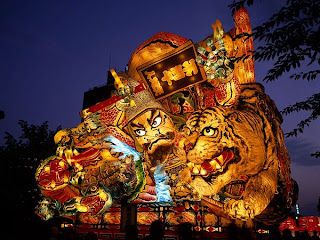
A geisha stands with sealed lips symbolizing a code of honor. Entertaining Japan’s male elite through music, dance, song, and conversation, geisha are valued as much for discretion as for beauty. The famed icons of Japanese culture have practiced their gei, or art, for over 250 years.
Geisha
A brilliantly decorated lantern float stands out against the summer night sky during the Neputa Festival in Hirosaki. Often depicting warriors and shaped like fans, the floats are accompanied by traditional drums. Folk festivals featuring traditional music, dance, and costume are an important cultural element in Japan.
Sumo wrestlers clash in a ring in Nagoya. Once supported by the patronage of emperors, Japan’s national sport has roots going back nearly 1,500 years. Short but intense, most matches last less than a minute, with the grandly attired gyoji serving as referee.
Paper lanterns decorated with script glow orange in Japan. The Japanese language commonly uses 15,000 kanji characters, which are borrowed from Chinese. Schoolchildren as young as seven must confront the language’s complexities, such as learning to write some of the 200-plus characters for the sound “shou.”
Rice cakes, or mochi, are a favorite in Japan, particularly during the New Year, when they are traditionally given as gifts, set out decoratively in the home, or offered at shrines and temples. Their surfaces dusted with flour, the sticky, glutinous cakes are often stuffed with sweet beans or served in soup and, when not made by hand in a complex process, are widely available in supermarkets.
Photos are from National Geographic.
Thursday, May 6, 2010
Japan: Its Culture and Attractions
Labels: beginner, intermediate, italk, japan, teacher's life
Posted by jo at Thursday, May 06, 2010
Subscribe to:
Post Comments (Atom)

0 comments:
Post a Comment